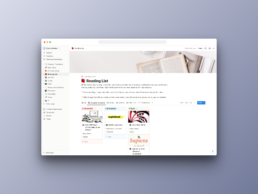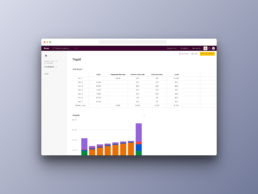Leveraging artificial intelligence (AI) tools can give your presentations a significant boost. There are many AIs that enhance content creation, data visualization, and accessibility. However, the most useful aspect of these design tools is their ability to make you a better presenter.
In this blog post, I will share five powerful AI tools that can take your decks to the next level, allowing you to captivate audiences and convey your message effectively. These are tools I have tested and regularly recommend to clients. While the names may be familiar, you may be surprised how they can be used to improve your slides.
Notion AI >
My first recommendation is to adopt Notion AI into your preparation process. Notion by itself is a powerful workspace where you can centralize your knowledge, slide text, and data. From there, its AI feature can summarize key points of the presentation within 30 seconds. You can even ask it to specify takeaways for different audiences, such as product demos, investors, performance overviews, and all-hands meetings.
Notion AI also has capabilities similar to Grammarly. You can ask it to help write, edit, translate, and simplify complex technical jargon. This can be instrumental to create more effective product demos for stakeholders who have less technical backgrounds. This is what I wrote about Notion in a recent article.

Finally, all your work in one place. Notion is a connected workspace where you can centralize all your knowledge and data.
Tellius Data Visualization >
Tellius Data Visualization is one of my favorite AI tools for analytics. It automates complex data analysis and presents it visually. This is helpful to understand key business drivers, market opportunities, and efficiency drivers.
Its first advantage is to cut down the time it takes to analyze these key performance insights and its second is its versatility. You can pull the visuals from Tellius and insert them in internal presentation templates, pitch decks, product demos, and more. If you’re responsible for regular all-hands meetings or internal updates, Tellius should be on your radar. It is especially useful for HR, marketing, sales, and business development teams.
Grammarly >
I’ve also mentioned Grammarly before, but it is still one of my most-used AI tools for content creation. Grammarly started out as an AI tool to improve your writing. Now, it’s tapped into AI to create GrammarlyGo, a real-time feature that provides content suggestions and can act as a personal writing assistant.
GrammarlyGo mimics your ideal brand voice to write in a tone appropriate for the presentation purpose (e.g., direct, empathetic, confident, or persuasive). This is helpful when generating text for slides and creating scripts for presenters.
Another advantage to Grammarly is that you’re not just constrained by using their platform to create your content. Its browser extension allows you to hook into Grammarly directly in your email, website, or Google Slides.
Rows >
Rows is another data visualization tool that stands out. It combines the power of ChatGPT, design, and spreadsheets. With it, you can transform raw data into meaningful charts, graphs, and dashboards that can then be integrated into your slides. I find it the most helpful when showcasing sales trends, articulating market insights in pitch decks, and presenting marketing metrics. The added bonus is that it significantly reduces analysis time for teams, similar to Tellius.
For presenters, Rows empowers you to deliver impactful visuals that engage your audience. These visuals can be particularly useful in product decks, pitch decks, and shareholder updates.
In a nutshell, Rows is an AI-powered spreadsheet with team collaboration and integration with your other SaaS tools.

Microsoft AI-Powered Live Captions >
Microsoft PowerPoint has been an early adaptor to integrating AI technology. One of the best AI tools it has championed is its AI-powered live caption and subtitle feature. Once selected, this feature will generate captions in presenter mode while you speak. It currently supports 60 languages and can translate your spoken word into another language.
Microsoft’s live caption feature makes your slides more inclusive and accessible to audiences. It also adds a more professional touch to your presentation. You can also use this feature to auto-generate subtitles for recorded product demos and other marketing videos.
Final Thoughts on AI Tools to Improve Your Presentations
The market is exploding right now with new AI tools geared toward helping presenters connect with their audience. It can be tempting to try all of them (and as someone who designs presentations for a living – I have been tempted). However, that can be a rabbit hole. Also, remember that the best presentations help the audience feel connected to your topic, whether it’s an internal all-hands meeting or a pitch to potential investors. Dare I say, great presentations create a human connection to the topic.
Over-utilizing AI tools can remove that critical element, making your deck feel pretty but cut and dry. This is because AI lacks humanity, at least for now. So, the key is to use AI to enhance elements of your presentation, not take over. Your presentation still needs you.
I hope these five tools allow you to dig deeper, faster, to create more impactful presentations. If you’re ready to put these tools to use in a new design, reach out to me.
Note:
I only recommend products I would use myself and all opinions expressed here are my own, but this article may contain affiliate links. Contact me for questions.
Borja Zamora
A Barcelona native but San Francisco based, Borja explores digital marketing and design through articles, images, and quotes.
Related Posts
December 15, 2023
10 Design Trends in 2024
Ask anyone and they’ll tell you the market is shifting. Most are probably…
August 30, 2023
Beyond Slides: Unconventional Presentation Formats That Will Wow Your Audience
Every presenter knows that great presentations are not remembered for the words…
March 28, 2023
10 Best AI-Powered Productivity Tools for Marketing Teams in 2023
AI productivity tools are the buzz of conversation right now among marketing…


